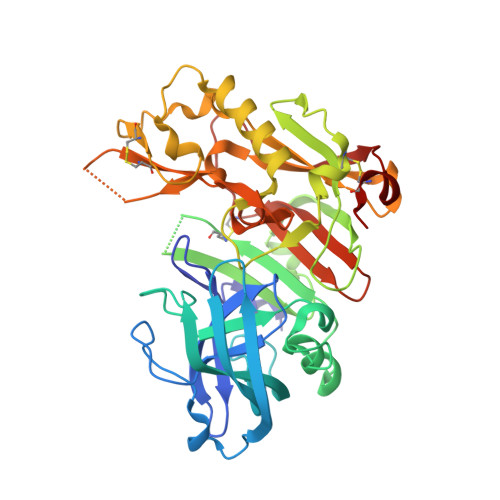Aminoethylenes: a tetrahedral intermediate isostere yielding potent inhibitors of the aspartyl protease BACE-1.
Yang, W., Lu, W., Lu, Y., Zhong, M., Sun, J., Thomas, A.E., Wilkinson, J.M., Fucini, R.V., Lam, M., Randal, M., Shi, X.P., Jacobs, J.W., McDowell, R.S., Gordon, E.M., Ballinger, M.D.(2006) J Med Chem 49: 839-842
- PubMed: 16451048
- DOI: https://doi.org/10.1021/jm0509142
- Primary Citation of Related Structures:
2FDP - PubMed Abstract:
A series of novel beta-site amyloid precursor protein cleaving enzyme (BACE-1) inhibitors containing an aminoethylene (AE) tetrahedral intermediate isostere were synthesized and evaluated in comparison to corresponding hydroxyethylene (HE) compounds. Enzymatic inhibitory values were similar for both isosteres, as were structure-activity relationships with respect to stereochemical preference and substituent variation (P2/P3, P1, and P2'); however, the AE compounds were markedly more potent in a cell-based assay for reduction of beta-secretase activity. The incorporation of preferred P2/P3, P1, and P2' substituents into the AE pharmacophore yielded compound 7, which possessed enzymatic and cell assay IC(50)s of 26 nM and 180 nM, respectively. A three-dimensional crystal structure of 7 in complex with BACE-1 revealed that the amino group of the inhibitor core engages the catalytic aspartates in a manner analogous to hydroxyl groups in HE inhibitors. The AE isostere class represents a promising advance in the development of BACE-1 inhibitors.
Organizational Affiliation:
Departments of Chemistry, Biochemistry, and Structural Biology, Sunesis Pharmaceuticals Incorporated, 341 Oyster Point Boulevard, South San Francisco, CA 94080, USA. wenjin@sunesis.com















